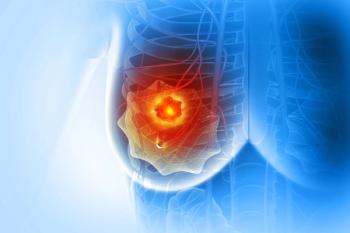
Combination of Ivosidenib Plus Azacitidine Produces Survival Benefit in Acute Myeloid Leukemia
Ivosidenib plus azacitidine shows benefits in event-free survival, overall survival, and clinical responses compared with placebo in patients with IDH1-mutated acute myeloid leukemia.
In the phase 3 AGILE study (NCT03173248), the combination of ivosidenib (Tibsovo) plus azacitidine (Vidaza) was found to produce benefits in event-free survival (EFS), overall survival (OS), and clinical responses compared with placebo plus azacitidine in patients with newly diagnosed, IDH1-mutated acute myeloid leukemia (AML). These findings were presented during the Annual Meeting of the Society of Hematologic Oncology (SOHO).
Presenter Courtney D. DiNardo, MD, MSCE, noted that the ivosidenib/azacitidine combination showed a favorable safety profile with manageable treatment-emergent adverse events (TEAEs). Further, patients treated with the combination had better health-related quality of life outcomes vs patients in the placebo plus azacitidine cohort.
The global, randomized, double-blind AGILE study randomized 200 patients 1:1 from 20 countries to receive oral ivosidenib 500 mg once daily plus azacitidine 75 mg/m2 subcutaneous or intravenously (n = 72) or a matching placebo combined with azacitidine (n = 74). The study’s primary end point was EFS, with secondary end points of complete response (CR) rate, OS, CR plus CR with hematologic recovery (CRh), and objective response rate.
Patients enrolled in both cohorts were over 18 years of age, with a median age of 76 years (range, 58-84 years) in the experimental cohort and 75.5 years (range, 45-94 years) in the control cohort, and had a centrally confirmed diagnosis of previously untreated AML with IDH1 mutation. Patients could not have been administered prior treatment with IDH1 inhibitors or hypomethylating agents for myelodysplastic syndrome.
Further, patients were required to have an ECOG performance status of 0 to 2, adequate liver and kidney function, and to be eligible for intensive chemotherapy. Most of the patients in both treatment arms were male and most had an ECOG performance score of 1 at baseline.
Disease history assessed at baseline showed that 75.0% of patients in the experimental cohort and 71.6% in the placebo cohort had de novo AML; whereas 25% of patients in the ivosidenib/azacitidine cohort and 28.4% of patients in the placebo/azacitidine cohort had secondary AML.
Most patients enrolled had an intermediate-risk disease, with a median percent of bone marrow blasts at baseline of 54% (range, 20%-95%) in the combination cohort and 48.0% (range, 17%-100%) in the placebo cohort.
The study found that at a median follow-up of 12.4 months, EFS improvements in the ivosidenib/azacitidine cohort were significant (HR, 0.33; 95% CI 0.16-0.69; 2-sided P = .0023) vs placebo/azacitidine. Patients who did not achieve a CR by week 24 were considered to have an EFS event at day 1 of randomization.
In the combination cohort, median EFS among patients who did not achieve a CR by week 24 was not evaluable (NE; 95% CI, 14.8-NE). Patients in the placebo cohort who did not achieve a CR by week 24 had a median EFS of 17.8 months (95% CI, 9.3-NE). EFS benefit with the ivosidenib/azacitidine combination was consistent across the study’s subgroups.
Median OS with ivosidenib plus azacitidine was 24.0 months compared with 7.9 months in the placebo cohort (HR, 0.44; 95% CI, 0.27-0.73; 2-sided P = 0.001). ORR with ivosidenib/azacitidine was 62.5% with a CRh rate of 52.8% and a CR rate of 47.2% compared with an ORR of 18.9% with a 17.6% CRh rate and 14.9% CR rate in the placebo group.
In terms of safety, 98.6% of patients in the combination cohort experienced any-grade TEAEs, and 93% experienced grade 3 or higher TEAEs. Hematologic TEAEs of any grade were experienced by 77.5% of patients and were grade 3 or higher in 70.4% of patients.
In the control cohort, any-grade TEAEs were observed in 100% of patients, and 94.5% experienced grade 3 or higher TEAEs. Any-grade hematologic TEAEs were observed in 65.8% of the control cohort and were grade 3 or higher in 64.4%.
The most common any-grade hematologic TEAEs in the combination cohort compared with the placebo cohort, respectively, were anemia (31.0% vs 28.8%), febrile neutropenia (28.2% vs 34.2%), neutropenia (28.2% vs 16.4%), and thrombocytopenia (28.2% vs 20.5%). The most common TEAEs in the combination arm compared with the placebo cohort, respectively, were nausea (42.3% vs 38.4%), vomiting (40.8% vs 26.0%), diarrhea (35.3% vs 35.6%), pyrexia (33.8% vs 39.7%), constipation (26.8% vs 52.1%), and pneumonia (23.5% vs 31.5%).
Reference
Dohner H, Montesinos P, Polo S, et al. AGILE: a global, randomized, double-blind, phase 3 study of ivosidenib + azacitidine versus placebo + azacitidine in patients with newly diagnosed acute myeloid leukemia with an idh1 mutation. . Presented at: 10th Annual Meeting of the Society of Hematologic Oncology (SOHO 2022); September 28-October 1, 2022; Houston TX.
Newsletter
Stay informed on drug updates, treatment guidelines, and pharmacy practice trends—subscribe to Pharmacy Times for weekly clinical insights.














































































































































































































